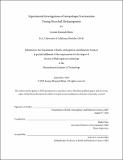Experimental investigations of isotopologue fractionation during microbial methanogenesis
Author(s)
Rhim, Jeemin Hannah.
Download1227037353-MIT.pdf (17.48Mb)
Other Contributors
Massachusetts Institute of Technology. Department of Earth, Atmospheric, and Planetary Sciences.
Advisor
Shuhei Ono.
Terms of use
Metadata
Show full item recordAbstract
The work described in this thesis explores and develops different culturing methods to test the following hypothesis: hydrogen concentration and redox potential are important controlling factors of carbon (¹³C/¹²C) and hydrogen (D/H) isotope ratios as well as the abundance of methane clumped isotopologues ([delta]¹³CH₃D) during microbial methanogenesis. Chapter 2 uses batch and fed-batch culturing systems to investigate the effects of H₂ concentrations on isotopologue fractionation. The results from fed-batch experiments confirmed the previous observation of decoupled ¹³C/¹²C and D/H systematics and provide experimental support for the hypothesis linking D/H and [delta]¹³CH₃D systematics. Results from a mathematical model indicated that the dissolved H₂ concentration, [H₂], at the cell surface can be up to an order of magnitude lower than [H₂] expected in equilibrium with the headspace mixing ratio, highlighting the importance and challenge in controlling [H₂] during fed-batch experiments. Chapter 3 and Chapter 4 present the application of bioelectrochemical system (BES) as a means to control methane production. In Chapter 3, mixed culture BESs were used to enrich for methanogenic microbial communities. Distinct molecular and morphological characterized the anodic and cathodic communities. Within the tested range, methane production and the D/H values of methane showed general correlations with applied potentials, indicating a promising application of this system in isotope studies. Chapter 4 introduces a new design of a pure culture BES to directly test the effects of cathode potentials on methane production and isotope signatures. Methane production decreased exponentially with increasing cathode potentials, up to 80 mV within the thermodynamic limit under our experimental conditions. Theoretical predictions indicate that the decrease in methane production rate is expected to be much more extreme at higher cathode potentials (<30 mV within the limit, for our system), while isotope data indicated a negative correlation between methane production rate and D/H values. This demonstrates the potential application of pure culture BESs to elucidate the origin of equilibrium isotope signatures in energy-limited environments often found in marine sediments. Limitations and future directions in the application of each experimental system explored in this thesis work are discussed at the end of each chapter.
Description
Thesis: Ph. D. in Geobiology, Massachusetts Institute of Technology, Department of Earth, Atmospheric, and Planetary Sciences, 2020 Cataloged from student-submitted PDF of thesis. Includes bibliographical references (pages 150-160).
Date issued
2020Department
Massachusetts Institute of Technology. Department of Earth, Atmospheric, and Planetary SciencesPublisher
Massachusetts Institute of Technology
Keywords
Earth, Atmospheric, and Planetary Sciences.